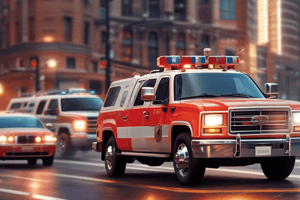Podcast
Questions and Answers
What is the purpose of the standard operating procedure described?
What is the purpose of the standard operating procedure described?
- To outline the requirements for GPS system usage
- To identify safe driving procedures for apparatus and vehicles (correct)
- To establish vehicle maintenance schedules
- To define the responsibilities of officers
What triggers an alert in the GPS system?
What triggers an alert in the GPS system?
- The vehicle is pinged every 5 minutes
- The vehicle exceeding the speed limit by any amount
- The vehicle exceeding the posted speed limit by 30 or more MPH for two consecutive pings (correct)
- The vehicle idling for less than 4 hours
Which of the following is a driving requirement for Fire Division vehicle operators?
Which of the following is a driving requirement for Fire Division vehicle operators?
- Possessing a commercial driving license
- Being accompanied by a passenger
- Being trained in vehicle maintenance
- Having a valid driver's license (correct)
What must all persons in the vehicle do before it is moved?
What must all persons in the vehicle do before it is moved?
Which behavior is specifically prohibited while riding in a moving vehicle?
Which behavior is specifically prohibited while riding in a moving vehicle?
What is a requirement for members providing emergency medical care in a moving vehicle?
What is a requirement for members providing emergency medical care in a moving vehicle?
Which of the following is NOT a driving alert criterion in the GPS system?
Which of the following is NOT a driving alert criterion in the GPS system?
What responsibility do drivers of Fire Division vehicles have?
What responsibility do drivers of Fire Division vehicles have?
What is the primary guideline for exceeding the speed limit during emergency responses?
What is the primary guideline for exceeding the speed limit during emergency responses?
What is the policy regarding the use of emergency lights and sirens on freeways?
What is the policy regarding the use of emergency lights and sirens on freeways?
What precaution should fire personnel take when passing other vehicles in the oncoming lane?
What precaution should fire personnel take when passing other vehicles in the oncoming lane?
At intersections, what must fire vehicles do when faced with a red light or stop sign?
At intersections, what must fire vehicles do when faced with a red light or stop sign?
When should fire personnel bring a vehicle to a complete stop during an emergency response?
When should fire personnel bring a vehicle to a complete stop during an emergency response?
During non-emergency travel, which statement is TRUE?
During non-emergency travel, which statement is TRUE?
What should be done whenever a fire apparatus is stopped and the driver is not in the seat?
What should be done whenever a fire apparatus is stopped and the driver is not in the seat?
What should be ensured before proceeding through any intersection in the oncoming lane?
What should be ensured before proceeding through any intersection in the oncoming lane?
Flashcards are hidden until you start studying
Study Notes
Safe Driving Procedures for Fire Apparatus and Vehicles
- Purpose: To establish safe driving procedures for all fire vehicles.
- MOU#2017-1: Implemented Global Position System (GPS) / Telematics and the collective Bargaining Agreement between the City of Columbus and Local 67.
- GPS System Alerts: Triggers alerts for exceeding speed limits, idling time, geographic location.
- Speed Limit Alerts: Exceeding speed limit by 30 MPH for two consecutive pings or exceeding 90 MPH.
- Idling Time Alerts: Vehicles idling for 4 hours or more.
- Geographic Location Alerts: Vehicles outside of Franklin County and its contiguous counties.
- Driver Responsibility: Drivers of all Fire Division vehicles are responsible for safe operation.
- Officer Supervision: When the driver is under direct supervision of an officer, the officer is responsible for the driver's actions.
- Riding Safely: All passengers must be seated and belted at all times while the vehicle is in motion.
- Emergency Care: Members performing emergency medical care while the vehicle is in motion should be secured to the vehicle by a seat belt or harness, when consistent with providing care.
- Emergency Response Speed Limits: Drivers shall obey the speed limit during emergency responses, but can exceed the limit under favorable conditions; all responses should be made safely with lights and sirens operating.
- Freeway Emergency Response: Drivers should travel with the flow of traffic and not exceed the posted speed limit.
- Oncoming Lane Travel: Proceed with extreme caution and ensure other drivers are aware of their presence and location.
- Oncoming Lane Intersections: Come to a complete stop and ensure safe passage before proceeding.
- Intersection Safety: Do not proceed through an intersection against a red light or stop sign unless it is safe, and ensure other drivers are aware of their presence and have their vehicles under control.
- Emergency Stops: Drivers should bring the vehicle to a complete stop when directed by a law enforcement officer, at blind intersections, when unable to account for all lanes of traffic, when other intersection hazards are present, when encountering a stopped school bus with flashing lights, and at all unguarded railroad crossings.
- Non-Emergency Travel: Drivers must obey all traffic control signals, signs, and laws of the road for the State of Ohio and City of Columbus.
- Apparatus Parking: The wheels of a FIRE apparatus must be chocked, front and back, when the driver is not in their seat.
Studying That Suits You
Use AI to generate personalized quizzes and flashcards to suit your learning preferences.




